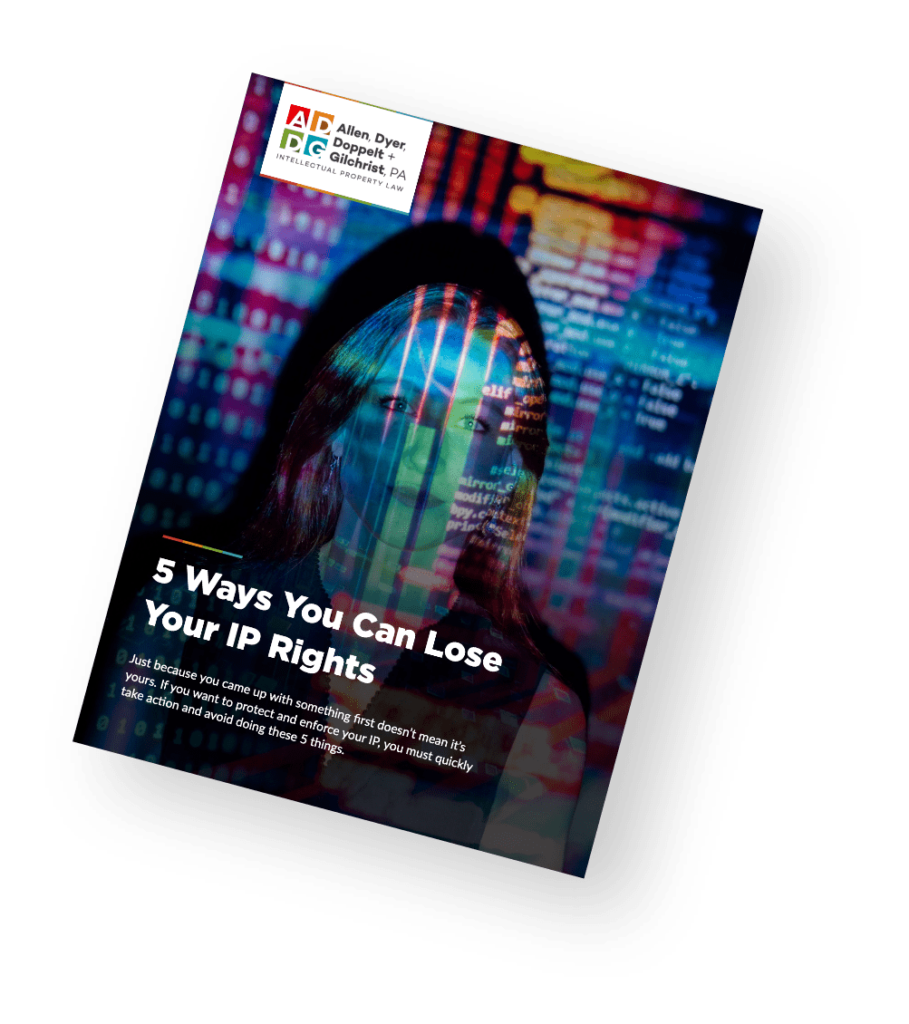- Home /
- Resource Center /
- Patent FAQs
U.S. Patent FAQs
A patent is a grant from the U.S. government of the right to exclude others from making, using, selling, or offering for sale the patented invention for a limited time. That is, a patent gives its owner the ability to seek an injunction through the federal court system to stop an infringer from making, using, selling, or offering for sale the patented invention during the term in which the patent is in force. Monetary damages may also be awarded for patent infringement.
No. A patent does not give its owner the unfettered right to make or sell the patented invention without recourse to other patent holders. In other words, one may obtain a patent on a product yet still infringe an earlier patent with claims that broadly read on the product. For example, if patent X claims elements A, B and C, someone may be able to later obtain patent Y claiming A, B, C and D. However, making a product with elements A, B, C, and D still infringes the claims of the patent X (because the product includes A, B, and C).
There are three types of patents, namely design patents, utility patents, and plant patents. Design patents protect the ornamental aspects of an article of manufacture. Utility patents protect new and useful processes, machines, articles of manufacture, or compositions of matter. Plant patents protect new varieties of asexually reproduced plants. Utility patents are appropriate for the vast majority of inventions.
A provisional patent application is an invention disclosure document that is filed with the USPTO that affords the inventor a priority date without meeting all of the formal requirements of a utility patent application. For example, a provisional patent application need not include claims, nor do the drawings have to comply with the formal drawing requirements. To receive the benefit of the provisional priority date, an applicant must file a utility application within one year of filing the provisional application and claim the benefit of the provisional application.
While a provisional application is an informal disclosure document that provides a relatively inexpensive way to quickly get a priority date for an invention, care should be taken in deciding whether its use is appropriate and, if so, in how the document is prepared. Even though the provisional application need not meet all of the formal utility application filing requirements, it still has to enable one of ordinary skill in the relevant art how to practice the invention ultimately claimed in the later filed utility application for those claims to receive the benefit of the provisional priority date. Moreover, the provisional application becomes a permanent part of the record or “file history” of the final patent. As such, a provisional application disclosure should be carefully reviewed or prepared by a patent attorney to make sure it does not include statements or terms that could later be problematic when attempting to enforce the resulting patent in court.
How long does a patent last? The term of a design patent extends 14 years from the issue date. Generally speaking, utility and plant patents have a term of 20 years from the filing date of the underlying application, although in some cases the length of the term or the date from which it is measured may be different.
In the United States, the patentability of any invention will generally depend upon the Patent Office’s decision, initially expressed by an Examiner, as to whether the invention is useful, novel, and unobvious. These requirements are set forth in the Patent Statute. In particular, Sections 102 and 103 relate to the differences between the invention and the prior art. Section 102 requires that an invention be novel in the sense that it has not been disclosed by any single prior art reference. Section 103 requires that the differences between the invention and the prior art be such that the invention would not have been obvious, at the time it was made, to a person having ordinary skill in the art.
A preliminary patentability search involves a search of the U.S. Patent and Trademark Office’s (USPTO’s) records to find the most pertinent prior art relating to an invention. “Prior art” is the existing body of technological information against which an invention is judged to determine if it is novel and non-obvious and can thus be patented. An inventor initially discusses the invention with his or her patent attorney, who then works with a professional search agent to locate the most pertinent references from the USPTO records. The patent attorney can then evaluate whether patent protection is likely to be available based upon the located references, as well as the potential scope of the patent protection. Knowing the potential scope of patent protection allows the inventor to make an informed business decision about whether seeking patent protection is worth the investment of time and money. Moreover, the results of the preliminary patentability search are invaluable to the patent attorney in crafting claims for the patent application that can withstand the USPTO’s scrutiny during the examination process.
The USPTO makes copies of issued patents and published applications available on its Web site, many of which are available for text or “key word” searching. Click here for the USPTO patent search page. The USPTO’s online database provides an excellent starting point for familiarizing oneself with the form and contents of a patent, as well as the types of patents available in a given field. However, the online search interface does not allow for the use of complex search strings, which often makes it difficult to locate and narrow down the most relevant search results to a manageable number. This is particularly true in art areas where thousands of patents and patent publications are available. Our professional search agents have access to the more sophisticated search systems in use at the USPTO and are therefore able to use their experience and expertise to quickly hone in on the most pertinent prior art.
Not at all. While the USPTO is an excellent source for determining what technical information is in the public domain, prior art is not limited to patent documents. Prior art may also include publications (articles, papers, etc.), sales of an invention, or even uses of the invention in public, none of which are covered in a typical preliminary patentability search. Moreover, patent applications currently are maintained in secrecy by the USPTO until they are published, which occurs sometime after the application has been pending for eighteen months. For these and other reasons, a preliminary patentability search is not a perfect representation of all of the art that may be applicable to a given invention. Even so, the publicly available repository of patents and published applications at the USPTO is one of the best single sources of prior art documents available. Moreover, this is the primary source of prior art the Examiner will use when he or she performs a search of a patent application. As such, the preliminary patentability search is a relatively inexpensive way to gain a great deal of information about the current state of the art.
If the preliminary patentability search results are favorable, this is when the patent attorney prepares the utility patent application. When the initial draft of the application is complete, the draft is provided to the inventor for his or her review to make sure the application is technically accurate and complete. The inventor’s comments are carefully considered in the preparation of the final draft, which is presented to the inventor for review prior to filing. The USPTO requires that each inventor sign a Declaration when the application is filed in the USPTO acknowledging a duty to disclose information of which he is aware and which may be considered to be material to the examination of the application. Such information may possibly include devices, products, publications, etc. which are similar to the invention and which were publicly known before the invention, and it may also include any public disclosure, commercial use, or offer of sale of the invention more than one year prior to the filing date of the application.
A utility patent application typically includes the following parts: background of the invention, summary of the invention, brief description of the drawings, and detailed description of the preferred embodiments, the claims, and an abstract of the disclosure. Of these, the claims are the heart of the application in that they define in words the scope of the invention for which the applicant seeks a limited monopoly from the government. The background sets forth the state of the relevant technical art and defines the need that the claimed invention fulfills. The abstract is a very brief summary of the claimed invention, and the summary section summarizes the claimed invention in further detail. The drawings illustrate the various elements of the invention recited in the claims, while the brief description of the drawings quickly orients the reader of the patent to what each drawing illustrates. Lastly, the detailed description of the preferred embodiments is where the elements of the drawings are described in further detail and various examples and embodiments of the invention are fully elaborated.
Once a utility (or provisional) patent application is filed with the USPTO, the inventor may then begin marking any products covered by the claims of the application as “patent pending,” so long as the application is actually pending before the USPTO. The “patent pending” indication serves as a warning to others who might otherwise make, use, or sell an identical product that patent protection is being sought from the USPTO.
Once an application is filed with the USPTO, it is assigned to the relevant technology area or “art unit,” and ultimately to the individual Examiner who will examine the application. The Examiner reviews the application to make sure it complies with the numerous USPTO rules and requirements, and he or she also performs a patentability search based upon the claims that are included in the application. Initially, the Examiner typically issues an Office Action report rejecting at least some of the claims and detailing the reasons for the rejection and the prior art upon which the rejection is based. It typically takes more than a year (and often two to three years) to receive a first Office Action from the USPTO depending upon the backlog of applications they have to examine in a particular art unit.
When an Office Action is received from the USPTO, your patent attorney (who receives correspondence from the USPTO on your behalf) studies the rejection set forth therein and advises you how best to proceed. Usually this involves preparing and filing a written response including arguments as to why the claims are patentable over the prior art cited by the Examiner and/or amendments more clearly defining the claims over this prior art. In some cases multiple Office Actions and responses are exchanged by the USPTO and applicant before a patent is ultimately granted or the application is abandoned.
Once an Examiner decides that an application is in condition for allowance, the USPTO issues a Notice of Allowance informing the applicant that the issue fee and publication fees are due. After issuance of the patent, the applicant is required to pay maintenance fees 3 ½, 7 ½, and 11 ½ years after the issue date to keep the patent in force. Click here for a list of current government patent fees.
The fees our firm charges depends upon the complexity and difficulty of preparing and prosecuting the application, which we can determine after reviewing your invention with you. Our firm’s charges for patent preparation services are competitive with the rates charged by other law firms with our level of experience, expertise, and commitment to excellence. Please contact us and speak with a Tampa or Miami patent attorney for further information. When we give you a quotation, it is intended to provide certainty to you as the client and to encourage you to communicate with your patent practitioner without concerns about being charged for every phone call and email, because it is important for you as the client and the patent practitioner to work together to achieve the best possible result for you.
In addition to the fees for the services of a Florida patent attorney or agent, there will be additional costs not included in our fee quotation such as U.S. Patent and Trademark Office filing fees, formal drawing preparation costs, search agent costs and the like. Additionally, the U.S. Patent and Trademark Office has issue and publication fees due at the time a patent application is allowed. Further, Patent and Trademark Office maintenance fees are due at 3-1/2, 7-1/2 and 11-1/2 years after a utility patent issues (no maintenance fees are required for design patents). Click here for a list of current U.S. Patent and Trademark Office fees.
Contact a Florida patent attorney from ADD&G for personable and experienced information regarding patent laws and regulations.
PLEASE NOTE: The information included herein is for informational purposes only. The Firm does not intend to create an attorney-client relationship with you by providing this information.



